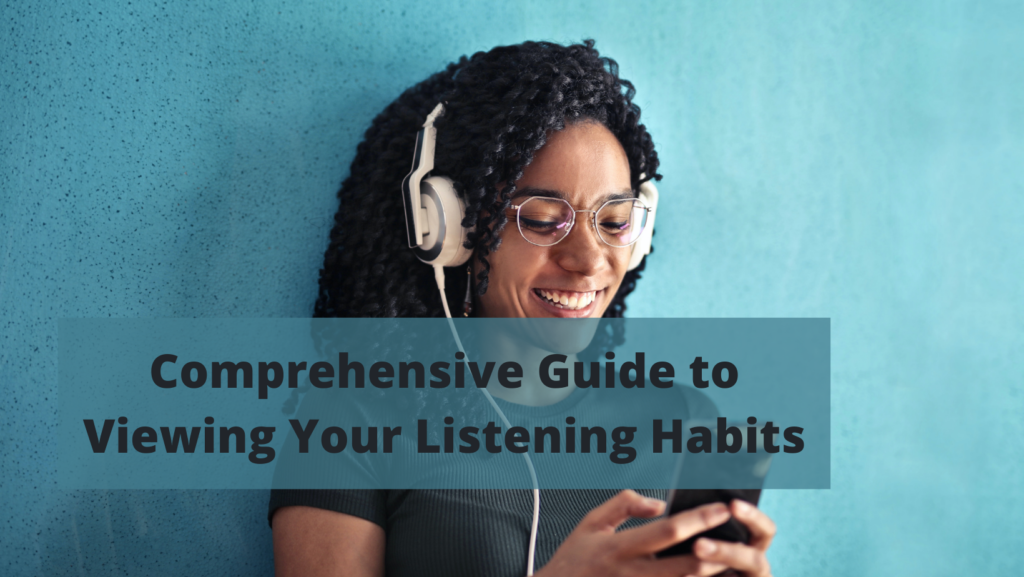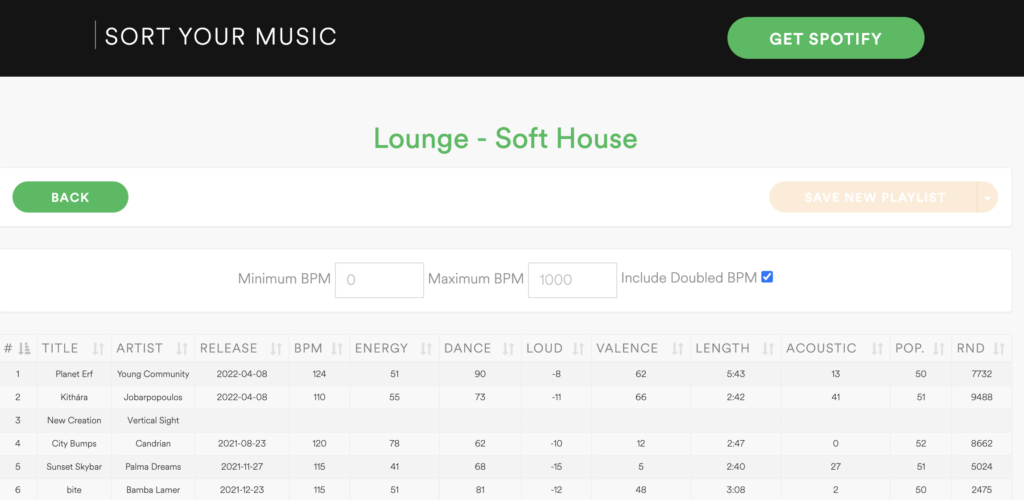Spotify is one of the world’s most popular music streaming services, with over 422 million active users. Whether you’re a die-hard Spotify fan or just starting to explore the service, it’s interesting to take a closer look at your listening habits and share them with friends.
The best Spotify stats websites allow you to do just that. In this guide, we’ll explore 10 different websites that give you insights into your Spotify data.
Spotify is one of the most popular streaming services, and for a good reason. Not only does it offer an impressive range of features, but it also boasts a huge selection of tracks and podcasts. However, one area where Spotify shines is in its statistics.

Spotify stats websites offer a wealth of information about your listening habits, including how many hours you’ve spent listening, your most-played artists, and your top tracks. This information can be extremely useful in helping you to improve your Spotify experience.
For example, if you’re finding that you’re not listening to as much new music as you’d like, you can use your Spotify stats to help you discover new artists and tracks. Alternatively, if you’re noticing that you’re starting to repeat the same songs repeatedly, you can use your stats to find new music that you’ll enjoy.
Ultimately, Spotify stats websites offer a valuable resource for anyone who wants to get the most out of their Spotify experience.
From Radio to Streaming
Commercial radio has been the primary way companies reach consumers for decades. But in recent years, that has begun to change.
In particular, the rise of streaming services like Spotify has profoundly impacted how people consume music. Not only do these services add significant incremental reach to commercial radio, but they also capture a larger audience of people 16+ across the country.
This is especially true for young adults, who are increasingly turning to stream services as their primary music source. As a result, companies that rely on commercial radio to reach consumers are at risk of missing out on a key demographic.
Spotify and other streaming services have already had a major impact on the music industry, and this trend will likely continue in the years to come.
The Best Spotify Stats Websites
Several Spotify stats websites offer users a range of different features. One of the most popular is Spotify Stats, which allows users to view Spotify data about their listening habits, share top tracks and songs with friends, and dig into a range of detailed statistics.
Other popular Spotify websites include Spotify Charts, which offers a real-time look at the most popular songs on Spotify, and Spotydata, which provides users with detailed information about their listening habits, including top artists, tracks, and playlists.

Each of these websites has its unique set of features, so it’s worth exploring them all to find the one that best meets your needs.
Fortunately, several Spotify stats websites can help you make the most of your Spotify experience. These websites offer a range of features that can help you improve your listening habits, find new music, and better manage your playback.
In addition, they also provide a wealth of data that can help you understand how Spotify works and how to get the most out of its features. These Spotify stats websites are worth checking out whether a casual listener or a power user.
Link your Spotify Account
All services below require access to your Spotify account. The first step is to link your Spotify account. To do this, click on the “Link your Spotify account” button on the website of your choice. This will redirect you to the Spotify login page, where you’ll need to enter your username and password.
After you’ve given the app permission to access your Spotify account, you’ll be redirected back to the website and look at your Spotify account data in reports that are now available on the Spotify website. View your most listened tracks, artists and genres with additional information wrapped around or presented differently.
Spotify App Data – Understanding my Data
When you use the automated Download your data tool, you’ll get a number of JSON files. The JavaScript Object Notation (JSON) format is a structured and widely used format that both computers and humans can understand. Third party websites listed below enhance your data based on your Spotify profile and allow you to create in some cases personal charts and based on your top tracks page see your Spotify usage in a new stimulating way.
1. Stats for Spotify
Stats for Spotify is a website that allows users to see an overview of the tracks, artists, and genres they listen to on Spotify. The website provides three periods to compare data, and users can see how their rankings change over time.
The website also allows users to create their own charts based on the music they listen to and provides an easy way to view data over time. Stats for Spotify is a helpful tool for Spotify users who want to see an overview of their listening habits and compare their data over time.

Stats for Spotify can help users better understand their music taste. The app provides data on the most popular music genres and artists and the user’s top tracks and artists. This information can be sorted by time period, giving users a snapshot of how their music taste has changed.
Stats for Spotify can also help users find new music to listen to by showing them their most played songs and suggesting similar tracks. In addition, the app provides links to artist pages so users can learn more about their favorite musicians.
Stats for Spotify is a valuable tool for anyone who wants a deeper understanding of their musical preferences.
Spotify Stats is a website that shows you all the data about your listening habits, including:
- The number of times you have listened to a song and how many times it has been played by other people
- How many times a song has been played in shuffle mode
2. Obscurify
Obscurify is a new Spotify stats website that offers users some of the features you’ll find in other Spotify stats websites while also giving you great insights into how obscure your tastes are compared to other users. While most people listen to popular music genres such as rock and dance, some music fans like to delve into more niche genres.
Obscurify is a website that allows you to check your Spotify stats. It offers all sorts of information, including streaming data and a social analysis of your content. Obscurify also shows how many people have listened to your songs, as well as how many times they’ve been played on repeat mode.
Obscurify gives users a window into the odder side of music taste, giving an Obscurity rating which lets you know how your library of tracks, artists, and genres compare to others in the country you select.
A great thing about Obscurify is that it’s easy to use, especially if you’re not familiar with using statistics websites like this one. All you need to do is enter your artist name or song title into the search bar at the top of the page, then click Submit Request. You’ll be taken through several steps from there:
- Entering in some personal information (like email address)
- Selecting which country you live in
- Picking one or more genres for music-related things such as “Rock” or “Pop”

Obscurify is a great way to see how your music taste stacks up against others, and it’s also a lot of fun to explore the more obscure side of the music world.
If you’re looking for a way to find new music that you might like, Obscurify is a great website to check out. Obscurify analyzes your playlists and presents your top genres along with the top five obscure artists in your playlists, so you can easily see how mainstream or not your music taste is.
It also makes recommendations based on your favorite tracks and artists, so if you’re curious about what other music you might like, Obscurify is a great resource.
Plus, the website is easy to use, and the results are presented in an easy-to-read graph, so you can quickly get an idea of what Obscurify has to offer.
The Obscurify Spotify stats website is an interesting site for people who enjoy obscure music. It analyzes your Spotify listening history and recommends songs that match your mood. It also gives you an overall rating and shows you which artists and songs are more obscure than others. You can even see what the top artists and songs are from each decade.
One of the most impressive features of Obscurify Spotify stats is that it displays how much space is required for downloading the songs in your playlists. You can even see how many songs are on each playlist. This makes it ideal for music lovers who are unsure of how much storage they need to download each playlist.
The website offers several interesting tools to analyze your music listening habits. For instance, you can see how popular different genres are. You can also view the top artists based on their popularity. The website also shows the mood and danceability of music. By using this feature, you can discover the best music and artists.
The Obscurify Spotify stats website provides a simple user interface that allows users to analyze their listening history. The statistics feature lets you see which artists and songs are the most popular among all listeners. You can view the chart for the past week, month, and year. You can also create playlists and share them with friends.
3. Receiptify
Receiptify is a free and open source website that tracks your Spotify usage. The site lets you see which songs you’ve played the most, as well as the most popular albums and tracks over the past few months. The website is designed to be easy to use and will let you share your music receipt on social media.
The site also analyzes your listening habits, including the most popular songs, artists, and genres. You can also generate playlists with these insights. You can even generate your own playlists by browsing through the Spotify app or the Receiptify website. Receptify is available for desktop and for Android and iOS devices.
The Receiptify Spotify stats site will allow you to download your Spotify playlists and view their statistics. You can export the data to TXT, CSV, JSON, or XML. The website also helps you organize your playlists by mood, and you can learn about the lyrics to a song. Receiptify is an excellent tool for Spotify listeners.
Receiptify offers several insights that are free to access. The most popular one, How Bad Is Your Streaming Music, asks you questions to find out which artists are your favorites. This site is very helpful when it comes to sharing your music on social media. Another great feature is the Zodiac Affinity feature, which pairs you with artists and tracks by your zodiac sign.
Receiptify is a free tool that lets you log in and check your Spotify earnings, number of streams, and more. You can also compare your earnings to other artists.
As a musician, it’s important to keep track of how things are going on the streaming front. Receiptify makes this easy with its convenient user interface and streamlined data tracking tools.
Receiptify is a simple but fun top tracks generator that creates a list of songs based on your listening habits. Receiptify takes your top songs from the last month, six months, or of all time and displays them in a classic receipt format.
The traditional receipt switches up the information, so the quantity represents the top tracks’ rank, the item displays the artist and song title, and the amount lists the song’s running time. Receiptify is a great way to rediscover old favorites and find new music to enjoy.

Receiptify is a fun little gimmick that does one thing and does it well – it takes your Spotify listening data and lays it out as a grocery store receipt. The Receiptify website is clean and easy to use, and within a few clicks, you can have your “receipt” generated and ready to share online.
Receiptify is free, so if you’re looking for a fun way to show off your latest Spotify listening habits, it’s definitely worth checking out.
4. Judge My Spotify
Judge My Spotify is a light-hearted web app that analyses your Spotify listening habits and gives you a score based on your taste in music.You can also use the service to see who your biggest fans are and what your most popular songs are. It provides a variety of other charts that show you how much progress you’ve made over time.

It’s an amusing way to find out whether your taste in music is good or bad, and it’s also a great way to discover new music. The app uses AI to judge your taste in music, and it can take into account different genre preferences, so you can see how you rank against other people who listen to the same type of music as you.

Judge My Spotify is a fun way to find out more about your taste in music, and it’s also a great way to discover new artists and songs that you might like.
Judge My Spotify is a web app that uses your top artists, songs, and genres to generate a satirical profile. The app doesn’t save any of your data, so you can use it without worrying about your privacy.
Judge My Spotify also doesn’t use real artificial intelligence. Judge My Spotify is a fun way to see how your taste in music compares to the rest of the world.

Spotify Stats are a tool that helps analyze your music tastes and listening habits. The app uses artificial intelligence (AI) to assess your taste and determine what you should listen to more. It also provides you with charts and daily Spotify statistics. Using the app can help you discover your own taste and decide whether you should listen to more mainstream music or more obscure music.
The app is available on both Android and desktop. There are also third-party apps and websites that offer Spotify stats. You can access these at any time to gauge your overall listening habits. There is also a feature called Spotify Wrapped that allows you to view your listening trends at any time. This feature is especially helpful if you want to find out which songs you listen to most often.
Another feature that makes Spotify stats more accurate is the AI that analyzes your listening history. It uses several factors to determine your music tastes, including how long you’ve been listening. The AI is designed to be as accurate as possible and can take some time to use. It also asks questions to get more accurate results.
If you’re curious to find out how good or bad your taste in music is, be sure to check out Judge My Spotify and get assistance from their famous sophisticated A.I. judges your awful taste in music.
5. MusicTaste.Space
MusicTaste.Space is a powerful Spotify stats tool that allows users to compare and share their listening habits with friends. MusicTaste.Space is a website that provides you with the best Spotify statistics. The site will show you your daily listening history, including your top artists, albums and songs. You can also see what you listened to the most and least, as well as when you started listening to certain artists. This website is very useful for finding out which artists you listen to the most in one day!
Space draws upon a good selection of factors to deliver its analysis, including the acoustic factors, energy, danceability, and happiness of your favorite artists and songs, comparing them to the U.S. national average.

Simply log onto their website to analyze your account’s songs and artists; their algorithm will let you know how compatible your tastes are with friends and family. MusicTaste.Space is a great way to discover new music and connect with friends over your shared taste in tunes!

MusicTaste.Space is a website that lets you see how your taste in music compares to your friends. Simply send them a link from the site’s homepage, and it’ll display all the overlap between your top artists and top songs. It’s a great tool to help you collaborate with friends, putting together a playlist of the best party songs for the next time you have a get-together.
And if you’re feeling bold, you can even use it to find new music to listen to outside of your comfort zone. So whether you’re looking to find new music or just want to see how your taste stacks up against your friends, MusicTaste.Space is worth checking out.
MusicTaste.Space is a website that allows users to analyze their Spotify listening habits and sort their music accordingly. The website uses data from Spotify to examine a user’s listening habits and determine the BPM and intensity of a track.
MusicTaste.Space also allows users to access the songs they and their friends have in common, based on the similarity percentage. In addition, the website provides users with playlists of new music to discover. MusicTaste.Space is a valuable resource for Spotify users who want to get the most out of their listening experience.
6. Discover Quickly
Discover Quickly is a website that aims to help Spotify users find new songs that they might like. The website has a range of filtering options allowing users to narrow their search. For example, users can choose to view only songs that are popular or that have high danceability.
Discover Quickly is a tool that helps you find new music. You can search for artists, albums, or songs to discover new tracks on Spotify. The site will automatically connect you with similar playlists based on your preferences and listening history.
Once you’ve found a playlist you like, save it to your profile so that you can access it later from any device!

Discover Quickly also has a list of Spotify’s exclusive genres, which can be helpful for users who want to create themed playlists. Discover Quickly is a useful tool for anyone who wants to find new music on Spotify.
Discover Quickly is a great way to find new music. You can browse by genre, artist, or mood, and you can preview tracks before you commit to adding them to your collection. But the best feature of Discover Quickly is the ability to hover over an album cover and trigger the song’s best part to start playing.

This way, you can get a taste of the track before you decide if it’s worth adding to your playlist. And if you’re not sure what you’re in the mood for, Discover Quickly also offers a Mood Radio feature that curates a selection of tracks based on your current state of mind.
Discover Quickly is an online tool that helps music fans find new and interesting artists and albums. The website works by allowing users to select a particular genre, after which it puts together a tailored playlist of tracks in the genre.
This makes it an invaluable resource for music fans looking to branch out into new and exciting artists and albums. Discover Quickly is also one of the best free music hosting sites available, making it even easier for users to find the content they want.
Discover Quickly is worth checking out whether you’re looking for something new or just trying to find the perfect song for your current mood.
7. Zodiac Affinity
Zodiac Affinity is a website that shows you what kind of music you should be listening to based on your zodiac sign. It’s pretty simple: just enter your birthday and choose from a list of the 12 astrological signs. Then, Zodiac Affinity will show you playlists tailored to your taste in music. These playlists are generated using Spotify’s own data, so they are pretty accurate (Spotify is known for having some of the best data around).
Zodiac Affinity’s interface is also very easy to use. All you have to do is click on “Listen Now,” choose a playlist that matches your zodiac sign, and press play! You can also scroll down further into each playlist to see which albums are included within them—if there are any that catch your eye but aren’t playing immediately after pressing ‘play,’ just click on their album cover art or title and they’ll s
Zodiac Affinity is a web data app that is somewhat limited in its functionality but still fun. The app matches up to five songs that line up with the user’s zodiac sign.
You must connect your Spotify account to Zodiac Affinity, select your star sign from the drop-down menu, and the app does the rest. Zodiac Affinity gives you five matching songs to enjoy based on your zodiac sign.

The app is limited in only matching songs from Spotify, but it is still a fun tool for astrology fans. Thanks to Zodiac Affinity, you can enjoy five tunes that are perfect for your zodiac sign.
Zodiac Affinity is a new app that claims to be able to tell you what type of music you like based on your star sign. Earth signs are more likely to enjoy jazz and classical, while those who fall under an air sign are more in tune with electronic-based dance music.
Looks like I did not listen to songs as my result:

If nothing else, it’s a fun way to discover new music. So whether you’re a skeptic or a believer, why not give Zodiac Affinity a try? You might just be surprised by the results.
8. Run BPM
Run BPM is a website that lets you find out the BPM of a song. You can use it to find the right tempo for your songs or to check the tempo of your workout music. It’s very simple and easy to use.
Run BPM is a playlist creation tool that uses beats per minute of tracks to help keep your energy levels high. Once you’ve logged onto the Run BPM site with your Spotify premium account, the system will filter through your library of music by tempo, matching the songs played to your pace.

Run BPM is a great way to boost your overall fitness and have some fun while doing it, with some studies demonstrating a beneficial effect of music tempo on exercise performance. One study found that runners who listened to music synchronized with their footfalls ran 3% faster than those who didn’t listen to music.
Run BPM takes the guesswork out of finding songs that match your pace, so you can focus on your run and reach your goals.

Run BPM is a new app that allows you to tailor your Spotify playlists to suit your running pace. The app is easy to use and only takes a few minutes to get started. To get Run BPM up and running (pardon the pun), you begin by importing one or more playlists from your own personal playlists or elsewhere.
Next, a selection of sliders allows you to tweak the BPM, energy, danceability, and other metrics, tailoring the results to suit your running pace. Run BPM is ideal for Spotify users who like to listen to music on the go, and with good security measures in place, you can be sure your data will remain safe.
Run BPM is the perfect way to ensure your music always matches your stride, whether running for fitness or just for fun.
9. Sort Your Music
You can sort your music in a variety of ways. You can sort your music by playlist, album, track, artist, and more. For example, if you click on an artist’s name or album title in the sidebar of the desktop app (or on mobile), it will bring up all of that artist’s tracks or albums. If you click on a specific track or album title (e.g., “The Scientist”), Spotify will open that particular song and load it into its own window so that there aren’t any other songs playing in the background while you listen to it.
Playlists are another way to organize your music collection—you can make them yourself using songs from different artists and genres, or use playlists that others have created for interest-based categories such as “mood” (elevator music), activity (“workout”) or genre (“classic rock”).
Sort Your Music is a new data analysis tool that offers Spotify users a new level of finesse regarding playlist categorization.
Sort Your Music allows you to sort your music by various additional values, including BPM, energy, danceability, loudness, valence, length, acoustic, and pop.
This means you can now create playlists perfectly tailored to your mood and taste.

Sort your Music is a simple and effective way to organize your Spotify playlists. Using SortYourMusic is easy: just log in with your Spotify credentials and choose the playlist you want to sort, using the column headings to select your desired value.
The SortYourMusic system is built around the Echo Nest song attributes system, an API designed for Spotify that operates as a developers’ music intelligence and data platform. This platform provides SortYourMusic with the ability to offer features like duplicate track removal and manual reordering, addition, and deletion.
With SortYourMusic, organizing your music is simple and easy – so you can spend more time listening to the tunes you love. So whether you’re looking for a high-energy workout playlist or a relaxing selection of acoustic tracks, Sort Your Music has you covered.
10. Skiley
Skiley is an excellent web app that can help unlock a decent selection of new tools and features for your Spotify account. With Skiley, you can order any playlist based on the album title, song name, artist name, or BPM. You can also shuffle your playlists.

Skiley is a music-streaming app that offers a unique way to listen to your favorite tunes. In addition to the usual options of streaming and downloading songs, Skiley allows you to split your playlist into multiple genres, or filter your songs based on specific criteria.
This makes it easy to find the perfect song for any mood or occasion. And if you’re looking for more than just music, Skiley also provides data on your playlists, including the ability to export to CSV, TXT, CFG, JSON, or XML.
Skiley is one of the best discover music bots because it gives you even more control over the music you listen to. Skelley makes it easy to find the perfect song for any mood, and its lyrics discovery feature is a great way to learn more about the music you love.

Skiley is a great way to manage your Spotify playlists by mood, and it even helps you discover the lyrics to any songs you enjoy. Skiley makes it easy to find new music that fits your mood, and you can even use Skiley to create custom playlists for specific occasions.
Skiley is also integrated with Discord, so you can control the music you listen to right from your chat app. If you’re looking for a way to take your Spotify listening experience to the next level, Skiley is worth checking out.
Skiley is one of the most comprehensive Spotify stats websites around. It connects to your Spotify account and provides numerous features, including playlists based on genre, artist, BPM, and audio properties. It also offers lyrics and translations of songs. The website also includes an extensive search function for finding songs that match your listening preferences.
Skiley can download data from your Spotify account and allows you to export it in TXT, CSV, JSON, or XML. Besides providing you with detailed information, Skiley also lets you manage playlists according to mood and genre. It can also help you find the lyrics of songs you like, so you can better understand which ones you should listen to. This website is a must-have for anyone who uses Spotify.
Skiley also offers playlist manager functionality, letting you browse and organize your playlists based on specific criteria, like BPM, acousticness, or energy level. You can also view song lyrics on the website in real-time. You can also save your sorted playlists to your account.
11. Social Blade
Social Blade is a website that offers a variety of stats tracking services. You can see how many followers you have on Spotify, how many plays your songs have gotten, and even revenue generated. Social Blade tracks different metrics such as play counts and streams over time so you can see how popular your music has been in the past.
12. Chartmetric
Chartmetric is another great site to check your Spotify stats. It provides you with all the information you need about your account, including:
- Total streams and monthly listens.
- Followers and chart positions.
- Top listened to songs and artists.
13. Spotify.Charts
Spotify.charts is a site that allows you to check your stats on Spotify. It will show you how popular your songs are in real time and give you a general idea of how many people have played them. You can check your daily plays, weekly plays, monthly plays and even yearly plays!
14. Audiomack
Audiomack is a music discovery platform that allows you to search for new artists and songs. It also has a feature called “My Mixtape” which allows users to save the songs they like, create playlists, listen to those playlists offline, or add them to their Spotify playlist. Audiomack provides some useful data about artists and songs, such as:
- The number of plays in the last week
- The number of plays over all time
- The most popular song by artist
15. Moodify
Moodify is an app that helps you discover new music based on your mood. You can also create custom playlists based on your preferences. Another popular website, MusicScapes, helps you create a virtual landscape from your Spotify listening habits. The website uses the mood, energy, and danceability of your favorite songs to create a landscape of sounds that you can enjoy.
The website also allows you to compare your Spotify tastes with people from your social circle. You can see what songs have the greatest impact on you, and compare them to those of your friends or strangers. You can also view genres and artists that are popular with others. If you’re unsure of your taste in music, you can filter the results by running BPMs or artists.
When using Spotify, make sure to save your playlists. This way, you can view them later. This website is also great for finding new artists. You can view the most popular songs of each artist, album, and track, and you can even create a playlist of your favorite artists and songs.
16. MusicScape
The MusicScape Spotify stats website analyzes your Spotify listening habits to create a landscape that you can explore. The website uses information about your last 24 hours of listening to create a unique view of your music tastes. The website also has a feature that allows you to turn any favorite tracks into playlists.
This website is a great way to see how many times you’ve listened to the same song or artist. It also provides useful insight into your moods. It can help you make better choices in your playlist based on what makes you feel happy or sad. You can even see the lyrics of the songs. It’s a wonderful website to use if you’re a Spotify user.
It offers a number of free tools that can help you organize your Spotify music. For example, you can view playlists by artist, genre, or danceability. It also analyzes other Spotify users’ listening habits and shows you how you stack up to them.
There are many ways to check your stats on Spotify.
- The first thing you should do is check your stats on socialblade. Socialblade is a free tool that allows you to track the growth of your artist profile, and it’s one of the most popular tools for checking Spotify statistics.
- Another way to check your stats is with chartmetric, which offers a variety of options, including data about playlists and songs.
- You can also go straight to spotifycharts.com, which tracks all sorts of streaming-related data, including top artists, albums and tracks by country or genre—and it’s free!
- If all these sites seem too complicated for you (or if they’re not working), then try spotifystats.com; this site provides an easy-to-use interface where anyone can easily look up their data from this platform without having any prior knowledge about web design or coding skills!
Conclusion
Spotify is a music streaming service with over 182 million premium subscribers worldwide. Spotify offers a free ad-supported service and a premium subscription service.
You can use these websites to check your Spotify stats. They are all free, with some requiring that you sign up for an account first. You can also use them to see what artists are popular in your area or worldwide, which is a great way to find new music!
The premium subscription removes ads, allows offline listening, and gives users higher-quality audio. Spotify also has a web player and apps for iOS, Android, Windows Phone, and BlackBerry devices.
There are some great web resources for Spotify users who want to dive into their stats and improve their listening experience. We’ve covered ten of the best Spotify stats websites, from humorous web apps that “print” your top tracks as receipts to in-depth tools to identify your tastes and offer suggestions for new music to listen to.
If you wonder about your Spotify statistics beyond your recently played artists, all your most streamed songs for any timeframe, and favorite genres, you need to use third-party apps. Spotify lets you view essential stats only; this is where a third-party app that supports custom date range, top genres page, and personal ranking
If you’re a Spotify user and want to get more out of your listening experience, check out these great web resources!
Best Spotify Stats Websites FAQ
What is the best Spotify stats website?
The best Spotify stats website is the one that fits your needs the best. If you’re looking for a humorous way to view your top tracks, try out Receiptify. If you want an in-depth tool to help you identify your musical tastes, check out SortYourMusic.
Do I need a premium Spotify subscription to use these websites?
No, you don’t need a premium subscription to use any of these websites. However, some of the features on these websites (such as offline listening and high-quality audio) may only be available to premium subscribers.
I’m not sure if I’m ready to commit to a premium subscription. Is there a way to try out Spotify Premium for free?
Yes, you can sign up for a free 30-day trial of Spotify Premium. After the trial ends, you’ll be automatically reverted to the free, ad-supported service.
What are some other great ways to get more out of my Spotify experience?
In addition to using the websites listed in this guide, you can also check out our list of the best Spotify tips and tricks. You can also find new music to listen to by following Spotify playlists or subscribing to a podcast about music.










